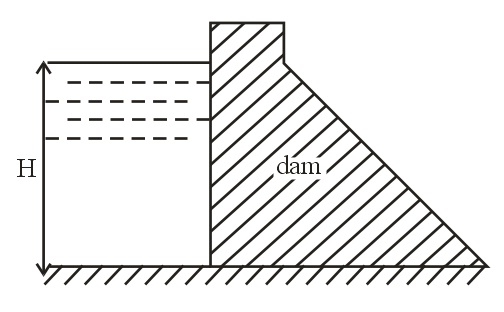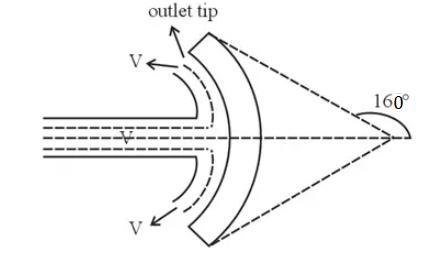Time Left - 12:00 mins
BARC 2019: Fluid Mechanics Nuclear Quiz-2
Attempt now to get your rank among 866 students!
Question 1
A ship moves horizontally in sea and its axis is 12 m below the surface of water. A U- tube manometer containing a fluid of specific gravity 2.5 connected along its axis and also a pitot-tube is attached just front of ship. The difference in the level of fluid in U–tube manometer is found to be 150 mm. The speed of the ship (in m/s) is (take specific gravity of sea water is 1.1)
Question 2
A dam is constructed across river for the purpose of irrigation. The depth of water (H) stored on the upstream side of dam is 5 m. The total pressure exerted on the upstream face for 1 m length of dam (in KN) is (assume g =10 m/s2) 

Question 3
A jet of water of 20 mm in diameter impinges on a fixed smooth curve vane at its centre on the concave side and deflected by 160 . The reaction of vane was 20 N when the discharge from jet was 2 litre/s. The ratio of theoretical to actual force of jet is
. The reaction of vane was 20 N when the discharge from jet was 2 litre/s. The ratio of theoretical to actual force of jet is

Question 4
In a steady flow of water, water is coming in through Pipe 1 (area 1 m2, velocity 1 m/s) and Pipe 2 (area 2 m2, velocity 2 m/s) and going out through Pipe 3 (area 2.5 m2). The exit velocity of Pipe 3 is?
Question 5
For a fluid element in 2-D flow field (x-y plane), if  it will undergo
it will undergo
Question 6
Fluid with velocity V flows over a flat plate and at a point δ is the boundary layer thickness. If the velocity is now increased to 9V, the boundary layer thickness (assuming only laminar flow exists) at that point is
Question 7
Find the value of p and q for which the flow will not get separated if velocity profile is given by
 , (u= Local velocity and U= free stream velocity) determine whether the flow:
, (u= Local velocity and U= free stream velocity) determine whether the flow:
 , (u= Local velocity and U= free stream velocity) determine whether the flow:
, (u= Local velocity and U= free stream velocity) determine whether the flow: Question 8
Air flows over a 10 m long plate. The transition from laminar to turbulent flow takes place between Reynolds number of 2.5 × 106 and 3.6 × 106. What is the maximum distance from the front edge of the plate along which one can expect laminar flow in the boundary layer? The free stream velocity is 30 m/s and kinematic viscosity (ν)= 1.5 ×10-5 m2/s.
Question 9
It was observed that the difference of heads between the two ends of a pipe 300m long and 0.25 m diameter is 1.8 m. Taking Darcy’s friction factor as 0.01 and neglecting minor losses, calculate the discharge flowing through pipe.
Question 10
A pipe 3200m long and 0.9m diameter is used to transport the water and at the end of this pipea a nozzle of 0.2m diameter is connected which converts all the energy into kinetic energy. Calculate the discharge of water at its discharge end, if head available at start is 300 m. Take f=0.024 for pipe.
- 866 attempts
- 3 upvotes
- 3 comments
Jul 15ESE & GATE ME

